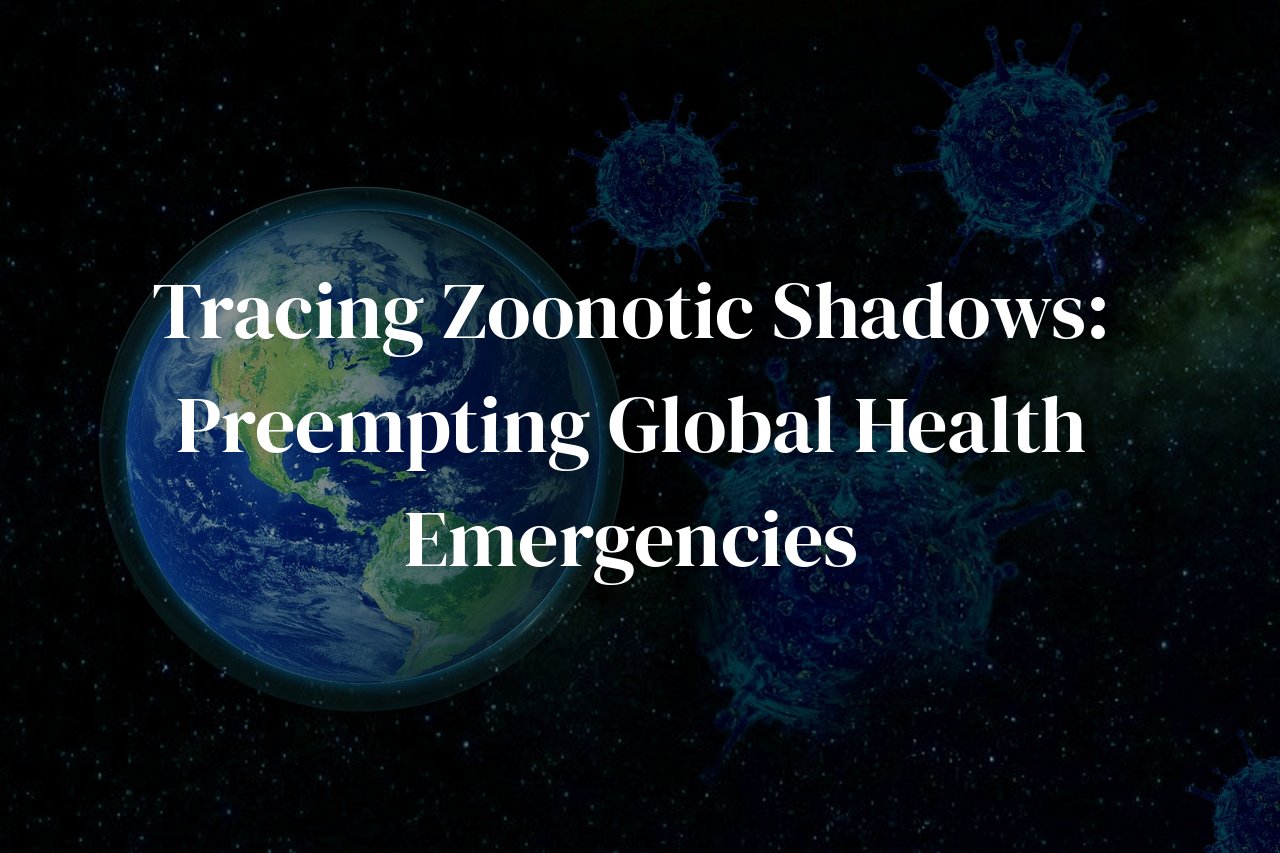
The emergence of pandemics that shake the very core of global health has necessitated a vigilant eye on the phenomenon of cross-species disease transmission. In our interconnected world, tracking the path of zoonotic ailments – those that jump from animals to humans – is not just a scientific quest, but a crucial safeguard for our collective future. This blog post will delve into the intricacies of monitoring animal diseases that have the potential to cross species barriers and the pivotal role this surveillance plays in preempting pandemics. As a seasoned medical blogger with a passion for public health, I will unpack the strategies and challenges of this monitoring process, illuminating how becoming informed can empower us to better predict and prevent the next global health crisis.
Table of Contents
Zoonotic Origins: Unveiling the Birthplace of Pandemics
As humanity encroaches deeper into the wild frontiers, the veil shrouding the origins of zoonotic diseases is gradually lifted, revealing the intricate dance of pathogens between species. In my journey into the realm of zoonoses, I’ve come to understand that these diseases do not simply appear; they are born from a complex interplay of ecological, biological, and social factors. Our quest to understand pandemics begins in the lush canopies of rainforests, the cramped confines of livestock markets, and the remote habitats where wildlife and human settlements collide.
On numerous occasions, I have witnessed firsthand the bustling wildlife markets, where the air is thick with potential pathogens, as animals stressed and out of their environment are mixed and mingled. It is here, in these chaotic crucibles of biological exchange, that the spillover of viruses like Nipah and influenza can occur. The market’s cacophony sometimes drowns out the quiet ticking of the pandemic clock, counting down to our next global health emergency.
It is not just about identifying a single culprit but understanding the environmental degradation that pushes animals out of their natural habitats, increasing contact and thus the likelihood of a pathogen finding a new host. Deforestation, for instance, is not only an ecological crisis but a prologue to a health catastrophe. My boots have been muddied by the slash-and-burn grounds that were once forests, a stark reminder that where trees fall, the seeds of future pandemics might take root.
In the manner of a detective piecing together clues from a crime scene, scientists are challenged to trace zoonotic origins back to their source. This endeavor means examining not only the pathogens and their hosts but the conditions that facilitate their meeting. Through sample collection in bat caves or analysis of livestock health, the aim is to catch a glimpse of pathogens on the brink of spilling over to humans, in what I’ve come to see as a ‘pre-jump’ phase, effectively acting as an early warning system.
Each outbreak teaches us anew about the fragility of our coexistence with nature. The previous Ebola outbreaks, some of which I’ve researched, serve as a sobering lesson in how human activities, like wild game consumption and land exploitation, can unseal Pandora’s box. Our interference with delicate ecological balances has shown time and again to be the harbinger of diseases such as SARS and MERS, which originate from creatures like bats and camels, that in turn affects our collective fate.
Surveilling the Animal Kingdom: Tactics in Disease Tracking
Waking up to a world grappling with a pandemic was not on my agenda. Yet here we are, drawing lessons from the whispers of nature. My journeys into wildlife ecosystems have pressed upon me the criticality of surveilling the animal kingdom and pre-emptive disease tracking. Those field trips, poring over data in the dense canopy of a rainforest or analyzing samples in the chilly rooms of wildlife vet labs, have revealed the sheer complexity of monitoring cross-species diseases.
In a landscape brimming with biodiversity, tracking zoonotic pathogens is akin to finding a needle in a haystack. Yet, innovative methods make the quest conceivable. A favored tactic is ‘EcoHealth Surveillance’, an approach that marries ecology with health by monitoring environmental changes which may be indicative of emerging diseases. Forest degradation, for instance, might signal increased contact between humans and wildlife hosts, presaging disease spillover. It’s a sentinel in the quiet before the storm.
Bioinformatics and genetic analyses have revolutionized how we unearth zoonotic threats. During one particular study, ‘Metagenomic Sequencing’ stood out. This technology doesn’t just identify known pathogens; it uncovers novel ones by analyzing genetic material straight from environmental samples. Enmeshed within the genetic code lay the clues of potential pandemics, waiting to be deciphered.
Animal behavior monitoring is another instrumental tool. Aberrations in migratory patterns or sudden die-offs can pinpoint where vigilance is needed. These abnormalities are often the heralds of an underlying pathogenic menace. The time I spent with ornithologists, who tracked avian flu through bird migrations, taught me the immense value of understanding animal movements and their implications for human health.
Let us not demit the role of serosurveillance. This involves regularly testing animal populations for antibodies to specific diseases. It’s the omnipresent guardian watching over the health of animal populations, alerting us to the murmurings of immunity or disease within them.
With each strategy, the goal remains resolute: detect the zoonotic whispers before they become a global shout. My immersion in this field, paired with the strategies utilized by a myriad of dedicated professionals, underlines the enormity of the task at hand: to surveil, understand, and hopefully curtail the next zoonotic threat with the grace of a panther pouncing on its unwitting prey.
Data’s Crucial Role: Informatics in Pandemic Prediction
In the intricate dance of zoonoses—those diseases that leap from animals to humans—the power of data is like a lighthouse piercing through a stormy night. I once plunged into the depths of epidemiological informatics, psychologically bracing for a complex labyrinth of raw numbers and case studies. What unfolded was an epiphany of how digitized data can be the heartbeat of pandemic prediction and ultimately, our salvation.
Take the enigmatic world of ‘Predictive Modeling’, a realm where algorithms scry into data to forecast the ripples of a potential outbreak. My interactions with predictive models taught me that they are not merely lines of code but rather oracles capable of translating numerical whispers into stark realities. By churning through data points from animal disease surveillance, travel patterns, genetic information, and even climate change metrics, these prophetic systems offer us a chance at foresight in the war against pandemics.
The significance of ‘Real-time Surveillance’ is another narrative of my journey through the thicket of disease informatics. I’ve marveled at how real-time data streams from remote sensors or community reports ladder up to the formation of a global mesh, a protective web alerting us to the stirrings of infectious agents crossing species barriers. It’s a testament to technology’s hand in crafting a shield of vigilance.
Diving deeper, ‘Genomic Sequencing and Bioinformatics’ emerged as heralds of a new era. The joy I found in dissecting genomic data was akin to decoding ancient tomes bearing the secrets of disease lineage and mutation patterns. These revelations are the cartographers’ tools, mapping the journey of pathogens from animal reservoirs to human hosts, enriching our understanding, and refining our defense strategies.
‘Data Integration and Interoperability’ became a personal crusade as I witnessed siloed datasets stifle innovation. The amalgamation of diverse data sets—epidemiological, veterinary, environmental—is akin to assembling a dream team of experts, each offering a unique perspective towards a holistic tapestry of knowledge. It’s a symphony where every note is essential for the integrity of the health surveillance opera.
But data is nothing without the human element—’Capacity Building and Training’. My sojourn in war rooms filled with aspiring data scientists emphasized this crucial endeavor. By nurturing proficiency in data literacy, we empower professionals to interpret and act on the data-derived insights with speed and precision. It is the hand that turns the key in the lock, unbolting the doors to proactive intervention.
The zest of these experiences, the real-world encounters with the transformative power of informatics in disease anticipation, has sewn within me an unwavering faith in our collective capability to outmaneuver pandemics. Informatics is not just data; it is the art of survival encoded in digits, a symphony of intellectual elegance, and above all, our shared flares of hope in the enveloping shadows of potential outbreaks.
Collaboration Across Borders: Global Strategies for Health Security
Once, while I was conversing with a field expert during an international health conference in Geneva, we stumbled upon a profound realization: our shared vulnerability links us more closely than our diverse geographical borders might suggest. A potent reminder of this is the critical need for worldwide collaboration in the face of zoonotic diseases, those elusive harbingers of pandemics.
In combating cross-species diseases, a united front transcends traditional alliances, fostering an environment where knowledge, resources, and best practices are seamlessly exchanged. For instance, The Global Health Security Agenda (GHSA), initiated in 2014, epitomizes this collaborative spirit by uniting nations to create a framework to strengthen global capacities to prevent, detect, and respond to infectious disease threats.
Crucially, international partnerships are the linchpin in crafting intricate surveillance networks, as I observed first-hand when participating in cross-border collaborations. These networks integrate cutting-edge technologies with on-the-ground epidemiological insights, forming a cohesive web of early warning and rapid response.
Pooled resource initiatives, such as the Coalition for Epidemic Preparedness Innovations (CEPI), are yet another nuanced chapter in this unfolding tale of cooperation. CEPI marshals the collective clout of public, private, philanthropic, and civil organizations to accelerate the development of vaccines against emerging infectious diseases.
On the policy-making arena, diplomatic dialogues and transnational treaties have shaped protocols that prioritize health security, striking the balance between sovereign rights and shared responsibilities. Engaging with officials and healthcare stakeholders, I heard impassioned discussions on how bilateral agreements and international health regulations fortify these global defenses.
The sentiment that resonates with me deepest is that amidst our interconnected patchwork of civilizations, no one nation can stand as an island in the fight against zoonotic diseases. It’s the shared pulse of humanity and our resolve to support one another that ultimately weaves the sturdy fabric of global health security.
From Detection to Action: Policies Shaping Pandemic Preparedness
The leap from identifying a potential zoonotic threat to implementing effective actions is pivotal in staving off global health emergencies. Throughout my engagements with healthcare policy experts, the recurrent narrative underscores the essence of robust, adaptive, and far-sighted policies. In one conversation with a seasoned epidemiologist, a key insight was that reactionary measures are often too little, too late. Instead, she emphasized proactive preparedness, which resonated deeply with me.
In my exploration of pandemic preparedness policies, I’ve come to appreciate the stratagem of establishing global surveillance networks. These networks enhance early detection capabilities, functioning as an interconnected web that draws in data from remote corners of the world—the epitome of vigilance.
The scale-up of predictive modeling is another fundamental policy directive. It isn’t just about gathering vast amounts of data but about harnessing it to forecast possible outbreak scenarios. This approach provides governments a critical window to mobilize resources, develop vaccines, and issue guidelines before the full impact of an outbreak is felt.
One of the most compelling discoveries was the implementation of cross-sector emergency response simulations. These practical drills, which I witnessed firsthand, bridge the gap between theoretical preparedness and real-world crisis management. They carve out flaws in existing systems, offering a canvass to paint corrective strokes on the grand mural of pandemic response.
Integrating One Health principles into national legislations forms the bedrock of preempting zoonotic diseases. A policy that resonates with me is the integration of environmental stewardship within health strategies, acknowledging that the health of humans, animals, and ecosystems is intrinsically linked. This reinforces the notion that we cannot operate in silos when combatting a threat that disregards borders and species lines.
Finally, the commitment to transparency and information sharing stands tall as a policy imperative. During an outbreak, misinformation can spread as fast as the virus itself, making clarity and honesty non-negotiable pillars in the architecture of response strategies. Clear communication channels need to be established, not just between nations but reaching down into communities, fortifying trust and cooperation when it is needed most.
Conclusion
Tracking the silent whispers of diseases that dance between species is a complex yet vital endeavor. Through vigilant monitoring and robust collaboration, the global community can embrace innovative tactics to stay a step ahead of potential pandemics. By understanding the importance of cross-species disease tracking, we can take proactive measures to safeguard not only our health but also the delicate balance of our ecosystem which we share with the animal kingdom. Knowledge, as showcased in this blog, is our most potent weapon in the war against unseen microbial threats.



